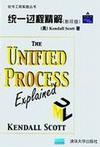统一过程精解
2004-4-1
清华大学出版社
斯科特
185
无
Many of the designations used by manufacturers and sellers to distinguish theri products are claimed as trademarks. Where those designatioins appear in this book, and Addison-Wesley was aware of a trademark claim, the designations have been printed with initial capital letters or in all cpitals.The author and publisher have taken care in the preparation of this book, but make no expressed or implied warranty of any kind and assume no responsibility for errors or omissions. No liability is assumed for incidental or consequential damages in connection with osr arising out of the use of the information or programs contained herein.
List of FiguresPrface Why This Book? Organization of This Book AcknowledgmentsChapter 1:Overview Introduction History Use Case Driven Architecture-Centric Understanding the Big Picture Organizing the Development Effort Facilitating the Possibilities for Reuse Evolving the System Guiding the Use Cases Iterative and Incremental Locical Progress Toward a Robust Architecture Dealing With Ongoing changes in Requirements Greater Flesibility to change the Plan Contiuous Integration Early Understanding Ongoing Focus on Risk The Four Phases Inception Elaboration Construction Transition The Five Workflows Requirements Analysis Design Implementation Test Iterations and Increments Artifacts,Workers,and Acivities Artifacts Workers ActivitiesChapter 2:The Requirements Workflow Introduction Artifacts Workers ActivitiesChapter 3:The Analysis WorkflowChapter 4:The Design WorkflowChapter 5:The Implementation WorkflowChapter 6:The Test WorkflowChapter 7:The Inception Phase Chapter 8:The Elaboration PhaseChapter 9:The Construction Phase Chapter 10:The Transition Phase Appendix A:The Rational Unified ProcessAppendix B:Extreme Programming and the RUPAppendix C:The ICONIX ProcessBibliographyGlossaryIndex

无